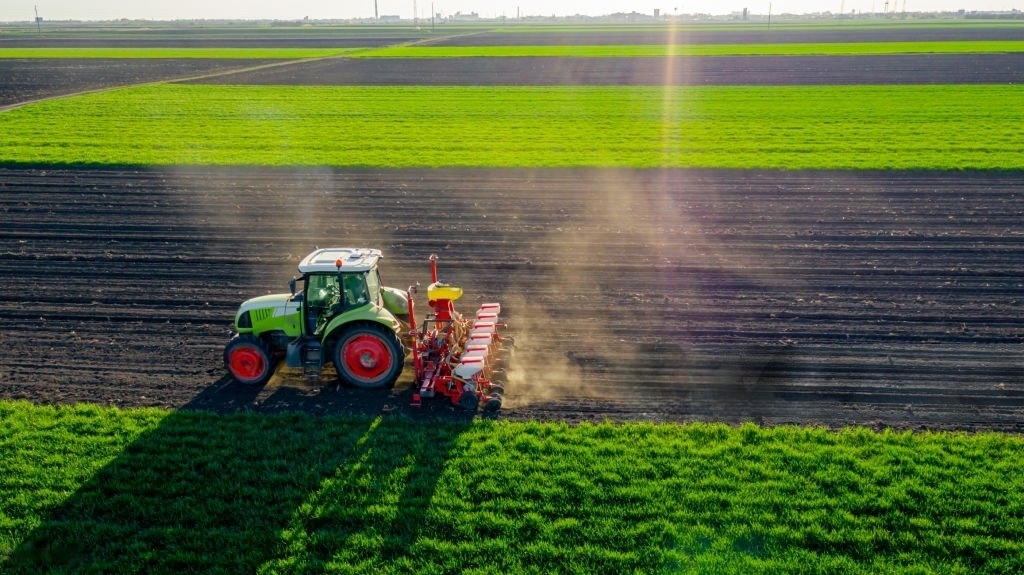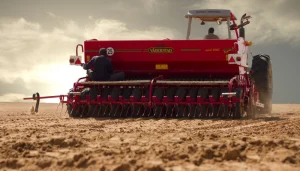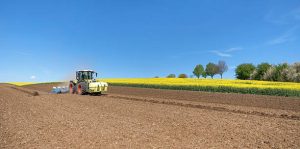seed drill is a machine used in agricultural It was invented in the early 1700s by Jethro Tull, an English farmer and inventor, and has since become an indispensable tool for farmers around the world.
The seed drill works by creating furrows in the soil and then dropping seeds into them at a consistent depth and spacing. This allows for more even distribution of seeds and ensures that they are planted at the optimal depth for germination. The seed drill also helps to conserve seeds, as they are not scattered haphazardly and wasted in the process.
Overall, the seed drill has revolutionized the way that farmers plant crops and has greatly increased efficiency and productivity in agriculture. While there have been many advancements in agricultural technology since its invention, the seed drill remains an important tool for farmers today.
Fundamentals of Seed Drill
Definition of Seed Drill
A seed drill is an agricultural machine used to sow seeds precisely and uniformly at a predetermined depth and spacing. It is used to plant crops like wheat, barley, and maize, among others. The machine consists of a seed hopper, a seed metering mechanism, a furrow opener, and a covering device.
The seed hopper holds the seeds, and the seed metering mechanism controls the flow of seeds into the furrow opener. The furrow opener creates a furrow in the soil, and the covering device covers the seeds with soil, ensuring that they are at the right depth.
History of Seed Drill
The seed drill was invented by Jethro Tull, an English agriculturist, in the early 18th century. He observed that the traditional method of broadcasting seeds by hand was wasteful and resulted in uneven germination and growth. He developed a machine that could sow seeds in rows at a uniform depth and spacing.
Tull’s seed drill was a significant improvement over the traditional method, and it revolutionized agriculture. It allowed farmers to plant crops more efficiently, resulting in higher yields and more significant profits. Over time, the seed drill has undergone many improvements and modifications, and today, it is an essential tool in modern agriculture.
In conclusion, the seed drill is a critical machine in agriculture that has revolutionized the way crops are planted. Its precise and uniform sowing of seeds has led to higher yields and more significant profits for farmers.
Components of Seed Drill
A seed drill is a machine that plants seeds in rows at a uniform depth and spacing. It is used to increase the efficiency of planting and reduce seed wastage. A seed drill consists of several components that work together to plant seeds accurately and efficiently.
Seed Hopper
The seed hopper is a container that holds the seeds. It is usually located at the top of the seed drill and is designed to hold a large amount of seeds. The hopper is equipped with a mechanism that regulates the flow of seeds to the seed tubes.
Seed Tubes
Seed tubes are long, narrow tubes that deliver seeds from the seed hopper to the furrow openers. They are designed to deliver seeds at a consistent rate and depth. The seed tubes are usually made of plastic or metal and are designed to prevent seed damage.
Furrow Openers
Furrow openers are the components that create the furrows or grooves in the soil where the seeds are planted. They are usually made of steel and are designed to penetrate the soil to the desired depth. The depth of the furrow can be adjusted to accommodate different seed sizes.
Seed Covering Devices
Seed covering devices are the components that cover the seeds with soil after they have been planted. They are usually located behind the furrow openers and can be adjusted to control the amount of soil covering the seeds. The covering devices are designed to ensure that the seeds are planted at the correct depth and are covered with soil to protect them from birds and other pests.
In conclusion, the seed drill is a critical machine that helps farmers plant seeds accurately and efficiently. The components of the seed drill work together to ensure that seeds are planted at the correct depth and spacing, reducing seed wastage and increasing crop yields.
Types of Seed Drills
Seed drills come in different types, each with unique features and capabilities. Here are the three main types of seed drills:
Mechanical Seed Drills
Mechanical seed drills are the most common type of seed drill. They are powered by a tractor and use a series of gears and chains to distribute seeds evenly across the soil. These drills can be adjusted to accommodate different seed sizes and planting depths. They are ideal for large-scale farming operations.
Pneumatic Seed Drills
Pneumatic seed drills use compressed air to distribute seeds. They are more precise than mechanical drills and can be adjusted to plant seeds at specific intervals and depths. Pneumatic drills are also less likely to damage seeds during planting. it is used in small-size farms.
Precision Seed Drills
Precision seed drills are the most advanced type of seed drill. They use GPS technology to plant seeds with extreme accuracy. These drills can plant seeds in straight lines, curves, and even around obstacles. Precision drills are ideal for planting crops in irregularly shaped fields. They are also the most expensive type of seed drill.
In summary, mechanical seed drills are the most common type of seed drill, pneumatic drills are more precise, and precision drills are the most advanced but also the most expensive. Farmers should choose the type of seed drill that best suits their needs and budget.
Advantages and Disadvantages of Seed Drill
Benefits of Using Seed Drill
Seed drill is a highly efficient machine that offers a range of benefits when it comes to planting crops. Some of the key benefits of using seed drill include:
- Accurate sowing: Seed drill ensures that the seeds are planted at the right depth and distance from each other, which leads to uniform germination and growth of crops.
- Time-saving: Seed drill allows farmers to plant crops much faster than traditional methods, which saves a lot of time and effort.
- Cost-effective: Using seed drill reduces the amount of seed wasted during planting, which can significantly reduce the overall cost of farming.
- Improved crop yield: By ensuring uniform germination and growth of crops, seed drill can help farmers achieve higher crop yields.
Drawbacks of Using Seed Drill
While seed drill offers a range of benefits, there are also some potential drawbacks to consider. Some of the key drawbacks of using seed drill include:
- Initial cost: Seed drill can be expensive to purchase, which may be a barrier for some farmers.
- Maintenance: Seed drill requires regular maintenance to ensure that it continues to function properly, which can be time-consuming and costly.
- Limited flexibility: Seed drill is designed to plant crops in straight rows, which may not be suitable for all types of crops or farming practices.
- Soil compaction: Seed drill can cause soil compaction, which can negatively impact soil health and crop growth over time.
Overall, while seed drill offers a range of benefits, farmers should carefully consider the potential drawbacks before investing in this technology.
Seed Drill in Modern Agriculture
Seed drill is a machine used in modern agriculture for sowing seeds. It is a significant improvement over traditional sowing methods, which were time-consuming and labor-intensive. Seed drills have revolutionized the way farmers sow seeds by making the process faster and more efficient.
Seed drills can be used for sowing a variety of crops, including wheat, barley, and corn. They come in different sizes and designs, ranging from small handheld seed drills to large tractor-mounted ones. The most common type of seed drill is the pneumatic seed drill, which uses air pressure to sow the seeds.
One of the main advantages of using a seed drill is that it ensures uniform seed placement. This is important for the proper growth and development of the crops. Seed drills also help in reducing seed wastage and increasing crop yields. They can sow seeds at a precise depth and spacing, which is essential for optimal plant growth.
In addition, seed drills can be used to sow cover crops, which are planted to protect the soil from erosion and improve soil health. Cover crops can also help in reducing weed growth and increasing soil fertility. Seed drills make it easier for farmers to sow cover crops, which can have a significant impact on the overall health and productivity of their farms.
Overall, seed drills are an essential tool for modern agriculture. They have revolutionized the way farmers sow seeds and have helped in increasing crop yields and improving soil health. With the continued development of new technologies, seed drills are expected to become even more efficient and effective in the coming years.
Conclusion
In conclusion, a seed drill is a vital tool for modern agriculture. It provides farmers with a precise and efficient way of planting seeds, which leads to higher crop yields and reduced labor costs. By using a seed drill, farmers can ensure that each seed is planted at the correct depth and spacing, which helps to minimize competition for resources and maximize the use of available land.
Moreover, seed drills can be used to plant a wide variety of crops, including cereals, legumes, and oilseeds. This versatility makes them an essential tool for farmers all around the world.
Overall, the use of seed drills has revolutionized the way we plant crops, making it more efficient, precise, and cost-effective. As technology continues to improve, we can expect to see even more advanced seed drills in the future, which will continue to help farmers meet the growing demand for food while minimizing their impact on the environment.




